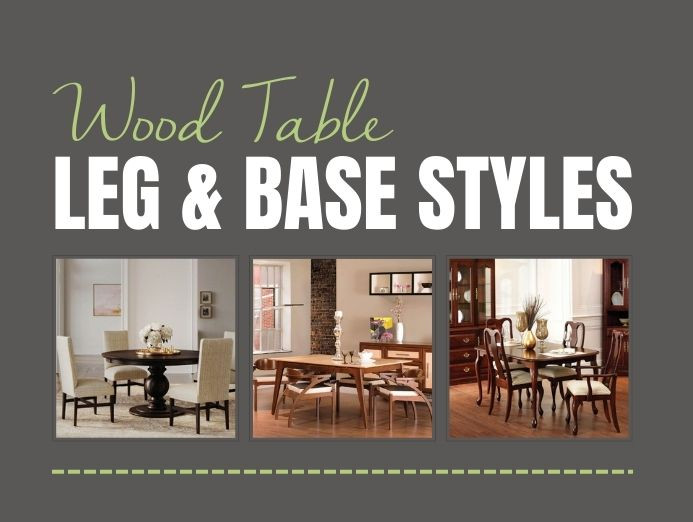Tips for Installing Dining Room Table Legs for a Modern Look
Tips for Installing Dining Room Table Legs for a Modern Look
Blog Article
From Typical to Modern: Find the Ideal Dining-room Table Legs for Your Style
While timeless designs such as cabriole and turned legs stimulate a feeling of classic class, modern designs like hairpin and geometric choices offer an opportunity for striking aesthetic rate of interest. As you think about these aspects, the inquiry stays: exactly how can you effortlessly integrate these diverse leg styles to develop an unified eating experience?
Understanding Table Leg Styles
The range of dining area table leg styles can considerably affect both the appearances and performance of the space. Each leg style adds special functional features and aesthetic aspects, dealing with varied layout preferences and use demands. Recognizing these designs is crucial for picking the best dining table that lines up with your overall interior decoration vision.
As an example, conical legs use a tidy, traditional look that can enhance a space's style, while pedestal bases supply stability and take full advantage of legroom, making them suitable for smaller sized rooms. Barrette legs, a trademark of mid-century modern layout, present an industrial flair, permitting a ventilated, open feeling. Trestle legs stimulate rustic charm, offering durable assistance and a feeling of timelessness.
Wooden legs can bring warmth and structure, whereas steel choices often share a smooth, modern vibe. Eventually, comprehending table leg styles is necessary for creating a natural eating location that mirrors personal style while making certain usefulness and convenience.
Typical Table Leg Options
When selecting eating space table legs, standard options usually embody classic style and craftsmanship. These styles show a rich heritage and a commitment to high quality, making them suitable for those who appreciate classic aesthetic appeals.
Among one of the most renowned traditional leg styles is the cabriole leg, characterized by its elegant curved form. This design commonly features attractive carvings and is most typically located in Queen Anne and Chippendale furniture. Another prominent choice is the transformed leg, which boasts a collection of smooth, rounded shapes that provide a timeless look while maintaining stability.
Moreover, the straight leg, while basic, uses a sturdy and unadorned structure that can blend perfectly with a range of tabletop designs. For those attracted to ornate describing, claw-and-ball feet legs evoke a feeling of majesty and can serve as a magnificent centerpiece in any type of eating room.
Lastly, stand bases, although not strictly legs, give an alternate conventional option that permits adequate legroom and can be perfectly carved. Each of these traditional leg designs adds to the overall setting of a dining-room, weding feature with visual charm.

Modern Table Leg Layouts
Modern table leg designs provide a diverse variety of designs that highlight ingenious materials and clean lines. These styles typically focus on capability while functioning as striking centerpieces within an eating space. Minimal visual appeals prevail, with legs crafted from products such as metal, glass, and crafted wood, which add to a ventilated and contemporary feel.
One popular layout is the barrette leg, characterized by its slender, conical framework that offers stability without frustrating the tabletop (dining room table legs). This design is typically found in mid-century modern furniture and can easily enhance various dining table forms. One more fad is using geometric forms, where legs might take on asymmetrical or angular kinds, including aesthetic rate of interest and a touch of artistry

Blending Styles for One-of-a-kind Areas
Usually, homeowners look for to develop distinct eating rooms that reflect their individual style by blending various layout elements. This technique permits the unification of varied visual appeals, causing a harmonious yet distinctive setting. Matching a rustic wood table with smooth, contemporary metal legs can create an attractive contrast that raises the space's total allure.
Additionally, incorporating vintage table legs with contemporary additional hints table tops can stimulate a sense of history while maintaining a modern sensibility. Such combinations not only display individual taste however additionally urge imagination, allowing homeowners to curate a room that feels both individual and welcoming.
Shade plays a vital role in this mixing procedure; picking table legs that enhance or comparison with the existing color pattern can enhance visual interest. For example, whitewashed legs can soften the boldness of a dark table surface, creating a well balanced visual.
Tips for Picking the Right Legs
Picking the right table legs is important for accomplishing both performance and aesthetic appeal in your eating space. Begin by considering the general design of your room. Standard settings benefit from legs that include complex makings or turned styles, while contemporary areas may require sleek, minimal styles.
Next, assess the elevation and stability of the legs. dining room table legs. Typical dining tables vary in between 28 to 30 inches in elevation, so guarantee the legs complement this dimension for comfort. Additionally, durable materials, such as hardwood or metal, can improve stability and longevity
Examine the leg shape too-- options consist of straight, tapered, or stand styles. Straight legs offer a traditional appearance, while tapered legs can include a touch of beauty. Pedestal bases provide adequate legroom and are why not try these out suitable for smaller sized rooms.
Verdict
In recap, choosing the perfect dining area table legs calls for cautious factor to consider of both modern-day and conventional styles. By harmonizing leg design, elevation, and product with the total decor, a natural and welcoming atmosphere can be accomplished.
The range of eating room table leg styles can considerably influence both the appearances and functionality of the space. Inevitably, understanding table leg designs is crucial for producing a cohesive eating location that mirrors individual style while ensuring functionality and comfort.One of the most legendary conventional leg styles is the cabriole leg, characterized by its stylish bent form. Straight legs use a traditional look, while conical legs can include a touch of sophistication.In summary, choosing the excellent dining space table legs calls for cautious consideration of both standard and modern styles.
Report this page